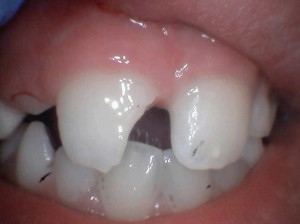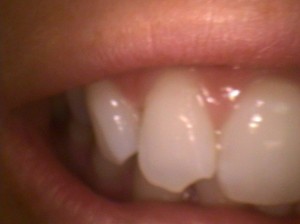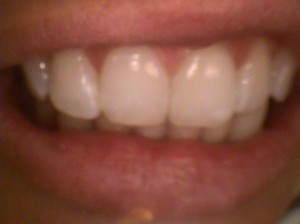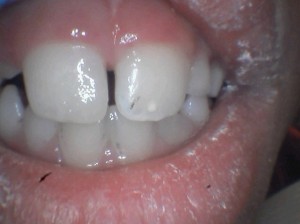I fell and broke my tooth. What should I do?
 Accidents happen. Unfortunately when they happen to teeth they don’t heal by themselves. The activities that most frequently cause tooth injury are skateboarding, bike riding or monkey bars. The most common team sports causing injuries include soccer, basketball, and water polo. Surprisingly the only time I have seen a football mouth injury was when the player took off his helmet to celebrate winning the championship and got his tooth knocked by his teammates helmet. The stupidest tooth injury was the drunk young man breaking his tooth showing off opening beer bottles. Perhaps the most bizarre was the young girl who tried to pull off one of those plastic ties holding her new shoes together using her teeth and instead pulled out her permanent front tooth. That was not good. One of the lessons to be learned is that teeth are not tools.
Accidents happen. Unfortunately when they happen to teeth they don’t heal by themselves. The activities that most frequently cause tooth injury are skateboarding, bike riding or monkey bars. The most common team sports causing injuries include soccer, basketball, and water polo. Surprisingly the only time I have seen a football mouth injury was when the player took off his helmet to celebrate winning the championship and got his tooth knocked by his teammates helmet. The stupidest tooth injury was the drunk young man breaking his tooth showing off opening beer bottles. Perhaps the most bizarre was the young girl who tried to pull off one of those plastic ties holding her new shoes together using her teeth and instead pulled out her permanent front tooth. That was not good. One of the lessons to be learned is that teeth are not tools.
Types of injuries to teeth
 Minor chips
Minor chips
Minor chips usually occur on the edge of the front teeth in the enamel portion of the tooth and are caused by a sharp, rapid, but not significant blow. The chip usually does not expose the softer sensitive tooth underneath. Often the edge has been thinned or weakened previously by the person grinding their teeth or natural attrition. The chip is so small you can not find the piece. Patients will say they bit into a fork, hit an olive pit or got knocked in the jaw. I have seen one cause so frequently that I have named it “the pretty girl chip.” The chip usually occurs at a party when a young man accidentally “bumps” into a pretty girl in an attempt to introduce himself. Unfortunately at that very moment she is drinking out of a glass or bottle. The resulting impact chips her front tooth. Believe me this in no way to make a good first impression. The picture on the right is a not so small “pretty girl chip.” (Forgive the blurry image, I am a dentist, not a photographer!)
 Minor chips represent no real danger to the tooth and are only an esthetic emergency. I realize it is still an emergency just the same. You can tell it is a minor chip if the chip is so small you can’t find the piece and there is no sharp pain on touching the tooth. Usually you notice it because the tooth feels rough to your tongue.
Minor chips represent no real danger to the tooth and are only an esthetic emergency. I realize it is still an emergency just the same. You can tell it is a minor chip if the chip is so small you can’t find the piece and there is no sharp pain on touching the tooth. Usually you notice it because the tooth feels rough to your tongue.
These type of injuries rarely cause damage to the nerve of the tooth. We usually take an x-ray so that we can follow any changes that might occur. The repair can be accomplished in two ways:
- If the chip is small enough we can just smooth the tooth. Often the tooth that got chipped is slightly longer and that is one of the reasons it got hit.
- If smoothing the tooth would shorten it esthetically we can bond the tooth with composite. This can often be accomplished using air abrasion without anesthesia as the soft part of the tooth is not exposed. We simply roughen the tooth with sand and bond matching porcelain material restoring the tooth.
Major fractures
A major fracture is caused by a significant blow to the mouth and results in large loss of tooth structure involving one or both corners of the tooth. The tooth will be sensitive or it may even feel numb. This is a true dental emergency where time is important. Call immediately. We want to protect the nerve in the tooth as soon as possible. The sooner it is protected the less likely a root canal will be needed. If you can find the piece of tooth bring it. Several different treatments can be used depending on the size of the fracture and whether the nerve itself was exposed.
 Bonding is the preferred treatment as it can restore the tooth with the least amount of additional trauma to the nerve. A root canal is not always necessary even if the nerve is exposed. Several different sedative treatments can be applied in order to help the nerve recover. Even if the tooth will eventually need a crown we will initially bond the tooth to give the nerve every chance to recover. Ideally if we have the piece of tooth we can simply re-bond the two parts together. I am amazed at how well this works and I have several patients with segments re-bonded for over 20 years who have never had to have a root canal. We will routinely monitor these teeth with x-rays and to check on the health of the nerve. The nerve can survive for a long time. I have a tooth that I hit with a surfboard at 17 years old. It was bonded several times and I eventually had to have a root canal 40 years later. Even if the tooth turns a darker shade a root canal may not be required. We can deal with the color change in several ways. (In the case of the image above, we did polish out the asphalt stain after the photo.)
Bonding is the preferred treatment as it can restore the tooth with the least amount of additional trauma to the nerve. A root canal is not always necessary even if the nerve is exposed. Several different sedative treatments can be applied in order to help the nerve recover. Even if the tooth will eventually need a crown we will initially bond the tooth to give the nerve every chance to recover. Ideally if we have the piece of tooth we can simply re-bond the two parts together. I am amazed at how well this works and I have several patients with segments re-bonded for over 20 years who have never had to have a root canal. We will routinely monitor these teeth with x-rays and to check on the health of the nerve. The nerve can survive for a long time. I have a tooth that I hit with a surfboard at 17 years old. It was bonded several times and I eventually had to have a root canal 40 years later. Even if the tooth turns a darker shade a root canal may not be required. We can deal with the color change in several ways. (In the case of the image above, we did polish out the asphalt stain after the photo.)
Severe fracture
A tooth shattered or root fractured below the bone may not be restorable, or have a very guarded prognosis. We used to attempt dental heroics much more often because to replace that single tooth required cutting down two good teeth to make a bridge. Now with the success of implants we have an alternative that can replace the weakened fractured piece with a stronger more predictable result.
We will cover what to do if your tooth is completely knocked out in a separate blog. If you have bleeding swelling or pain after an accident that is associated with your mouth, read our explanation of: What is a dental emergency?
